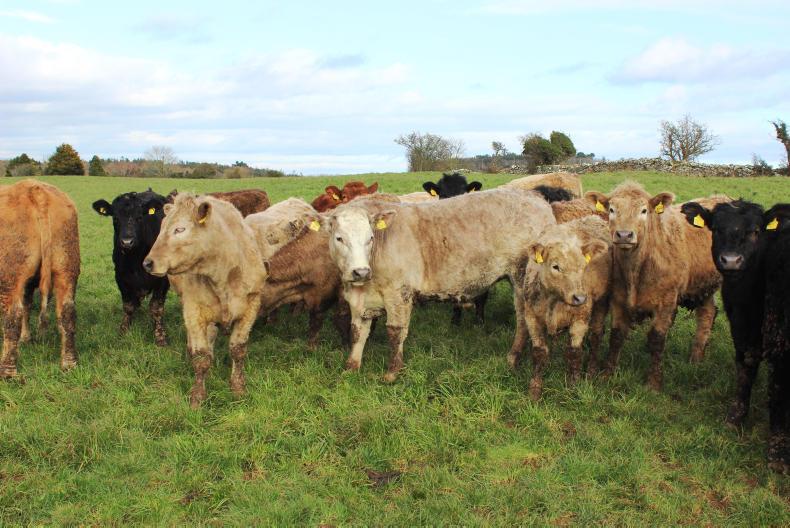There is nothing like an early turn-out to grass to boost liveweight gain in cattle. Weight gains from early spring grass can be as high as 2kg/day, albeit over a short period of six to eight weeks post-turn-out.
Over the coming weeks, there will be some opportunities to slip lighter cattle out to grass on drier land.
Planning ahead will help ensure they do not run out of grass. Before then, there are other steps to take so that cattle are in ideal condition to start grazing.
1. Reduce meal feeding
Weather and ground conditions will determine when cattle can go to grass, but there is no way of knowing what conditions will be like in early to mid-March.
Therefore, rather than cutting meal from cattle diets prior to turnout, it is more practical to cut feeding rates by half and continue feeding up until the target turn-out date.
For instance, take yearling cattle with a target turn-out date around 10 to 20 March. If cattle are currently on 2kg/day of ration, this can be cut to 1kg/day in late February and fed up until planned turn-out date.
Cattle are less likely to go to grass over-fat by reducing meal. Likewise, if turn-out is delayed by a month, cattle performance will not be compromised by continuing to feed 1kg/day until the later turn-out, compared with cutting meal from the diet completely.
2. Make sure all vaccines are up to date
Make sure all cattle vaccinations are up to date in spring- and autumn-born calves. This includes any respiratory and clostridial vaccines. With breeding stock, make sure BVD and lepto vaccines are up to date to save handling later.
3. Select higher priority stock first
Ground conditions will be tender in the spring, so choose lighter cattle to turn-out first. These animals will inflict less sward damage and grass covers will last longer, compared with grazing heavier animals.
Choose maiden heifers that will be bred during the summer for early turn-out, followed by store cattle that will be sold later this year.
Start small and build numbers as ground conditions and grass covers permit. Record all numbers of cattle in each grazing group, so animals can be located easily if necessary.
4. Turn out hungry
When turn-out day does arrive, it is a good idea to cut silage off cattle from the evening before. This way, cattle will go to grass hungry and ready to graze. Animals will settle faster and cause less ground damage.
5. Stand in holding pens before turn-out
Another tip to help cattle settle faster at grass is to let animals stand in handling pens for a short period before turn-out.
This way, cattle will be sporting in the pens and re-establishing a hierarchy when groups are mixed. Doing this in the handling pens will prevent swards being damaged.
Read more
Algeria opens for beef bulls over 500kg
Calf price key to profits of dairy beef
There is nothing like an early turn-out to grass to boost liveweight gain in cattle. Weight gains from early spring grass can be as high as 2kg/day, albeit over a short period of six to eight weeks post-turn-out.
Over the coming weeks, there will be some opportunities to slip lighter cattle out to grass on drier land.
Planning ahead will help ensure they do not run out of grass. Before then, there are other steps to take so that cattle are in ideal condition to start grazing.
1. Reduce meal feeding
Weather and ground conditions will determine when cattle can go to grass, but there is no way of knowing what conditions will be like in early to mid-March.
Therefore, rather than cutting meal from cattle diets prior to turnout, it is more practical to cut feeding rates by half and continue feeding up until the target turn-out date.
For instance, take yearling cattle with a target turn-out date around 10 to 20 March. If cattle are currently on 2kg/day of ration, this can be cut to 1kg/day in late February and fed up until planned turn-out date.
Cattle are less likely to go to grass over-fat by reducing meal. Likewise, if turn-out is delayed by a month, cattle performance will not be compromised by continuing to feed 1kg/day until the later turn-out, compared with cutting meal from the diet completely.
2. Make sure all vaccines are up to date
Make sure all cattle vaccinations are up to date in spring- and autumn-born calves. This includes any respiratory and clostridial vaccines. With breeding stock, make sure BVD and lepto vaccines are up to date to save handling later.
3. Select higher priority stock first
Ground conditions will be tender in the spring, so choose lighter cattle to turn-out first. These animals will inflict less sward damage and grass covers will last longer, compared with grazing heavier animals.
Choose maiden heifers that will be bred during the summer for early turn-out, followed by store cattle that will be sold later this year.
Start small and build numbers as ground conditions and grass covers permit. Record all numbers of cattle in each grazing group, so animals can be located easily if necessary.
4. Turn out hungry
When turn-out day does arrive, it is a good idea to cut silage off cattle from the evening before. This way, cattle will go to grass hungry and ready to graze. Animals will settle faster and cause less ground damage.
5. Stand in holding pens before turn-out
Another tip to help cattle settle faster at grass is to let animals stand in handling pens for a short period before turn-out.
This way, cattle will be sporting in the pens and re-establishing a hierarchy when groups are mixed. Doing this in the handling pens will prevent swards being damaged.
Read more
Algeria opens for beef bulls over 500kg
Calf price key to profits of dairy beef






 This is a subscriber-only article
This is a subscriber-only article









SHARING OPTIONS: